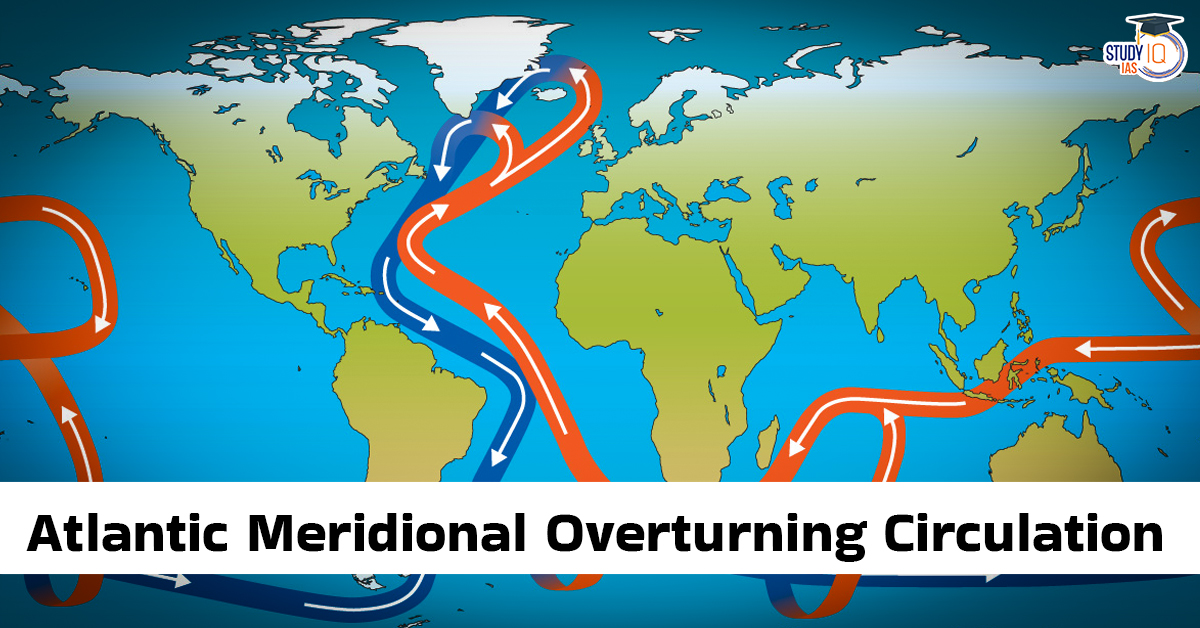Table of Contents
The Atlantic Meridional Overturning Circulation (AMOC) is one of the Earth’s most important oceanic circulation systems. Often referred to as the “engine” of global climate,” it redistributes heat, regulates weather patterns, drives monsoon systems, and impacts sea levels. In recent years, scientists have warned that AMOC is weakening due to global warming — with potentially catastrophic consequences for climate stability worldwide.
This article explains what AMOC is, how it works, why it is weakening, and what its collapse could mean for India and the world.
What Is the AMOC?
The Atlantic Meridional Overturning Circulation is a large system of ocean currents that transports warm, salty water from the tropics to the North Atlantic, where it cools, sinks, and flows back southward at deeper levels.
Key Components:
-
Gulf Stream
-
North Atlantic Deep Water (NADW)
-
Thermohaline circulation (temperature + salinity–driven)
AMOC helps moderate temperatures globally and maintain climatic balance.
How AMOC Works (Simplified Mechanism)
-
Warm water from the tropics flows northward via the Gulf Stream.
-
In the North Atlantic, the water cools and becomes denser.
-
The cold, salty water sinks to the deep ocean.
-
It then travels southward as deep currents.
-
Eventually, it resurfaces and the cycle continues.
This continuous movement drives global heat transport, influencing weather systems, monsoons, and rainfall patterns.
Is the AMOC Weakening? What Scientists Say
Research shows that AMOC is at its weakest point in at least 1,000 years.
Reasons:
-
Rapid Arctic warming
-
Melting Greenland ice sheet adding freshwater
-
Increased rainfall decreasing water salinity
-
Ocean warming, reducing water density
Freshwater reduces salinity, making it harder for water to sink — slowing the entire circulation.
Several studies (including in Nature Climate Change) warn that AMOC could collapse this century, possibly between 2025–2100, if emissions continue.
Global Climate Impacts of AMOC Slowdown or Collapse
If AMOC weakens significantly or collapses, the consequences would be far-reaching:
1. Extreme Cooling in Europe
-
Western and Northern Europe could face 2–10°C temperature drops.
-
Harsh winters, crop failures, and energy demand spikes.
2. Disruption of Monsoons (India, Africa, Asia)
-
Weaker AMOC = weaker monsoons.
-
Could reduce rainfall in India and West Africa.
-
Increased risk of droughts and food insecurity.
3. Sea-Level Rise Along U.S. East Coast
Slowed Gulf Stream leads to rapid sea-level rise, threatening coastal cities.
4. Intensified Hurricanes
Warm waters in the tropics can fuel stronger Atlantic hurricanes.
5. Collapse of Marine Ecosystems
Changes in ocean temperature and nutrient flow would disrupt fisheries and biodiversity.
Impact on India
AMOC plays a significant role in the Indian monsoon system.
A slowdown could lead to:
-
Weaker monsoons
-
Reduced rainfall over India
-
Agriculture losses
-
Greater food insecurity
-
Heatwaves and prolonged droughts
Some models predict up to 20% reduction in monsoon rains if AMOC collapses.
What Is Causing AMOC Weakening?
Primary drivers:
-
Global warming
-
Freshwater influx from melting ice
-
Declining salinity in the North Atlantic
-
Changes in precipitation patterns
Human-induced climate change is the top contributor, according to IPCC reports.
How Do Scientists Monitor AMOC?
Tools and systems include:
-
RAPID-MOCHA array (UK–US monitoring system at 26.5°N)
-
Satellite altimetry
-
Argo floats
-
Ocean temperature and salinity sensors
-
Paleoclimate data from sediments and ice cores
These help researchers detect changes in ocean circulation.
Is AMOC Collapse Certain?
Not yet — but the risk is rising rapidly.
IPCC Assessment:
AMOC collapse this century is unlikely (but not impossible), yet impacts would be “severe and irreversible.”
Several new studies warn:
AMOC could approach a tipping point sooner than expected, possibly before 2050.
What Can Be Done?
AMOC strengthening requires global climate mitigation, including:
-
Rapid reduction of CO₂ emissions
-
Controlling Arctic ice melt
-
Reducing global warming
-
Strengthening climate adaptation plans
-
International cooperation on climate research
AMOC does not respond quickly — so preventing collapse is far easier than reversing it.
Conclusion
The Atlantic Meridional Overturning Circulation (AMOC) is a critical climate stabilizer. Its slowdown is a warning sign of accelerating global warming and potential tipping points. The impacts — weakened monsoons, disrupted weather systems, extreme cooling in Europe, and global socioeconomic consequences — could reshape climatic and geopolitical landscapes.
AMOC’s future hinges on global climate action. The next decade will be decisive in preventing one of the most dangerous climate system collapses in human history.


 Data Protection Rules 2025: Key Features...
Data Protection Rules 2025: Key Features...
 Global TB Report 2025: India’s Progres...
Global TB Report 2025: India’s Progres...
 Climate and Health Funders Coalition
Climate and Health Funders Coalition

























